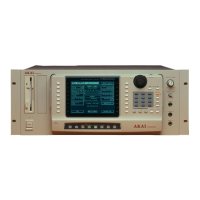Version 1.21 37
s5000
/
s6000
MULTI
MULTI
Once you have some sounds in memory, you will want to play them. This is done in the MULTI
mode.
Programs may be played singly or in combination and the MULTI mode has up to 128 ‘parts’ -
slots into which programs may be assigned and typically, this is used to sequence several sounds
multi-timbrally by setting each part to be on a different MIDI channel.
However, you don’t
have
to use the multi mode multi-timbrally - you can assign just one program
to it if you want and just play that from your keyboard or whatever. In a similar way, it is also
possible to assign several programs to a multi and set them to the same MIDI channel so that you
can layer two or more programs on top of each other for a rich, expansive (expensive?) sound.
Furthermore, you may set low and high keyboard ranges for each part so that sophisticated keyboard
splits may be created.
Each part may be routed to one of the four effects channels and you have a total of four effects that
can be applied to the parts in the multi
7
. More than one part may be routed to any one of the
effects channels so that parts may share effects and each part has its own effects send level.
Effects settings are stored with each multi so that as you select different multis, so the correct
effects are recalled.
However, you may prefer to use your sampler with external effects processors using a mixing
console. To accommodate this, each part may be routed to the individual outputs. By doing this,
each part may have its own mixer channel where it can be EQ’d, mixed, panned and effected
using your favourite outboard effects processors. The individual outputs may be configured as
stereo pairs and/or as individual mono outputs.
Of course, a combination of these is possible and some parts may be on unique MIDI channels
whilst others share the same channels for layering and/or key splits. Some parts may be routed to
the internal effects processor in the S6000 whilst others are sent out via the individual outputs for
processing on the mixing console.
As you can see, the MULTI mode is very flexible.
Furthermore, you may load up 128 multis into memory allowing you to switch from one setup of
sounds to another very quickly.
7 On the S5000, the EB20 is optional.

